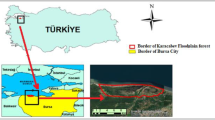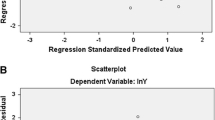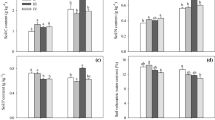Abstract
The spatial distribution of standing fine roots in tree rows of different species in a 12-year-old mixed stand of ash (Fraxinus mandshurica Rupr.) and larch (Larix olgensis Henry) was studied by soil core sampling in early spring, 2001. It is found that ash and larch differ greatly in their belowground biomass distribution. Ash has much higher fine root biomass density in the soil than larch at stand level (with the max value of 4442.3 vs. 2234.9 g·m−3). Both tree species deployed more fine roots in their neighboring zone, suggesting a less intensive competition between roots of the two species. Both fine root biomass density and root length density of ash in the zone between larch tree rows are greater than that of larch in zone between ash tree rows, indicating that ash is more powerful than larch in belowground competition. The spatial distribution feature of roots favors the growth of ash in the mixed stand.
Similar content being viewed by others
References
Böhm, W. 1979. Methods of studying root systems [M]. New York: Springer-berlag.
Chen Xiangwei, Zhang Guozhen, Zhang Huayan. 1997. Growth effect of Manchurian ash in mixed stands [C]. In: Shen Guofang, Zhai Mingpu (eds): Research on mixed forest plantations. Beijing: China Forestry Publishing House, p120–124. (in Chinese)
Einsmann, J.C., Jones, R.H., Mou Pu, Michell, R.J. 1999. Nutrient foraging traits in 10 co-occurring plant species of contrasting life forms [J]. Journal of Ecology,87: 609–619.
Eissenstat, D.M., Wells, C.E., Yanai, R.D. and Whitbeck, J.L. 2000. Building roots in a changing environment: implication for root longevity [J]. New Phytologist,147: 33–42.
Fahey, T.J., and Hughes, J.W. 1994. Fine root dynamics in a northern hardwood forest ecosystem, Hubbard Brook Experimental Forest, NH [J]. Journal of Ecology,82: 533–548.
Gerier, C.C.et al. 1981. Biomass distribution and above-and Below-ground Production in young and matureAbies amabilis zone ecosystem of the Washington Cascade [J]. Can J. For. Res.,11: 155–167.
Gholhz, H.L.et al. 1986. Organic matter dynamics of fine roots in plantations of slash pine (Pinus elliottii) in north Florida [J]. Can. J. For. Res.,16: 529–538.
Grime, J.P., Campbell, B.D., Mackey, J.M.L., Crick, J.C. 1991. Root plasticity, Nitrogen capture and competitive ability [C]. Plant root Growth: An Ecological perspective, (ed. D. Atkinson). Oxford: Blackwell Scientific Publications. pp. 381–397.
Hendrick, R.L. and Pregitzer, K.S. 1993. Patterns of fine root mortality in two sugar maple forests [J]. Nature,361: 59–61.
Hutchings, M.J., Wijesinghe, D.K., & John, E.A. 2000. The effects of heterogeneous nutrient supply on plant performance: a survey of responses, with special reference to clonal herbs [C]. In: Huntchingset al. (Eds.) The ecological consequences of environmental heterogeneity. Oxford: Blackwell Science. pp. 91–110.
Jackson, R.B. and Caldwell, M.M. 1989. The time and degree of root proliferation in fertile-soil micro sites for three cil-desert perennials [J]. Oecologia,81: 149–153.
Jackson, R.B., and Caldwell, M.M. 1996. Integrating resource heterogeneity & plant plasticity: Modeling nitrate & phosphate uptake in a patch soil environment [J]. Journal of Ecology,84: 891–903.
Mou Pu, R.J. Michell, R.H. Jones. 1997. Root distribution of two tree species under a heterogeneous nutrient environment [J]. J. of Applied Ecology,34: 645–656.
Nadelhoffer, K.J. 2000. The potential effects of nitrogen deposition on fine-root production in forest ecosystems [J]. New Phytologist,147: 131–139.
Pielou, E.C. 1988. The world of Northern Evergreens [M]. Ithaca and London: Gomstock Publishing Associates. pp: 1–7.
Silander, J.A. & Pacala, S.W. 1990. The application of plant population dynamic models to understanding plant competition [C]. In: Grace J.B. & Tilman D. (eds) Perspectives on Plant Competition. New York: Academic Press, pp: 67–92.
Smith, S.E. & Read, D.J. 1997. Mycorrhizal symbiosis [M]. San Diego, CA: Academic Press. pp: 134–146.
Wang Qingcheng, Zhang Yandong, Lin Daibin. 1997. Photosynthetic Characteristics of Ash and Larch in Mixture Stand [J]. Journal of Forestry Research,8(3): 144–147.
Zhang Yandong, Wang Qingcheng, Zhang Guozhen. 1997. Soil phosphorus activation mechanism in the mixture plantation of ash and larch [C]. In: Shen Guofang, Zhai Mingpu (eds), Research on mixed forest plantations. Beijing: China Forestry Publishing House. pp: 136–140. (in Chinese)
Author information
Authors and Affiliations
Additional information
Foundation item: This study was supported by National Natural Science Foundation of China (Grant No. 30130160), and the Quick Response of Basic Research Supporting Program (Grant No. 2102)
Biography: WANG Qing-cheng (1963-), male, associate professor in College of Forest Resources and Environment, Northeast Forestry University, Harbin 150040, P.R. China.
Responsible editor: Song Funan
Rights and permissions
About this article
Cite this article
Qing-cheng, W. Spatial distribution of fine roots of larch and ash in the mixed plantation stand. Journal of Forestry Research 13, 265–268 (2002). https://doi.org/10.1007/BF02860088
Received:
Issue Date:
DOI: https://doi.org/10.1007/BF02860088




